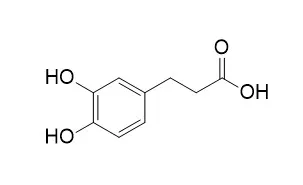| Kinase Assay: |
| Food Chemistry, 2007, 103(4):1075-1079. | | Inhibitory effects of substrate analogues on enzyme activity and substrate specificities of mushroom tyrosinase.[Reference: WebLink] | Tyrosinase can catalyze the oxidation of o-diphenols to o-quinones.
METHODS AND RESULTS:
In this paper, some o-diphenols were used as mushroom tyrosinase substrates to study the catalyzed specificity of the enzyme. The enzyme kinetic analysis of substrate specificities and the substrate analogues towards mushroom tyrosinase has been investigated. Taking l-3,4-dihydroxyphenylalanine (I), 3,4-Dihydroxyhydrocinnamic acid (II), 3,4-dihydroxycinnamic acid (III) and 1,2,4-benzenetriol (IV) as substrates, the results of specificity studies showed that the oxidation reaction of tested o-diphenols by mushroom tyrosinase followed Michaelis–Menten kinetics. The Michaelis–Menten constants for these four substrates were determined to be 0.615, 1.238, 0.331 and 1.886 mM, respectively. The values of Vm/Km, which denotes the affinity of the enzyme to the substrate, were determined and compared, and the results showed that the affinity of the enzyme to these substrates followed the order: compound IV > III > I > II. Furthermore, mushroom tyrosinase cannot catalyze the oxidation of 3,4-dihydroxybenzonitrile (a), 3,4-dihydroxybenzaldehyde (b), 3,4-dihydroxybenzoic acid (c) and 2,3-dihydroxybenzoic acid (d). On the contrary, compounds a, b and c can inhibit the activity of tyrosinase for the oxidation of DOPA, while compound d had no effects on enzyme activity.
CONCLUSIONS:
The results show that compounds a and b are reversible non-competitive inhibitors.
|
|






 Cell. 2018 Jan 11;172(1-2):249-261.e12. doi: 10.1016/j.cell.2017.12.019.IF=36.216(2019)
Cell. 2018 Jan 11;172(1-2):249-261.e12. doi: 10.1016/j.cell.2017.12.019.IF=36.216(2019) Cell Metab. 2020 Mar 3;31(3):534-548.e5. doi: 10.1016/j.cmet.2020.01.002.IF=22.415(2019)
Cell Metab. 2020 Mar 3;31(3):534-548.e5. doi: 10.1016/j.cmet.2020.01.002.IF=22.415(2019) Mol Cell. 2017 Nov 16;68(4):673-685.e6. doi: 10.1016/j.molcel.2017.10.022.IF=14.548(2019)
Mol Cell. 2017 Nov 16;68(4):673-685.e6. doi: 10.1016/j.molcel.2017.10.022.IF=14.548(2019)